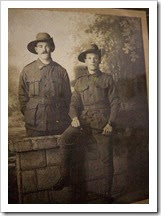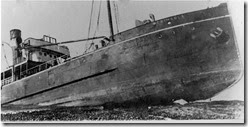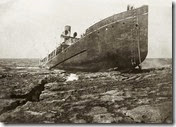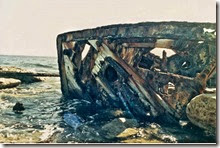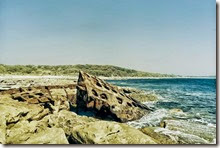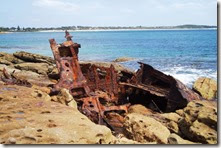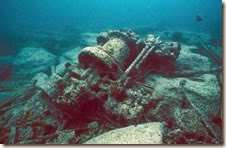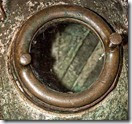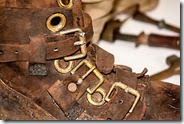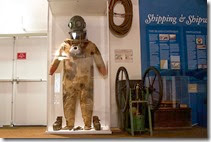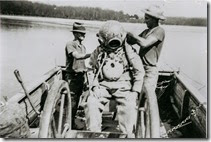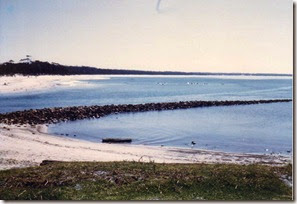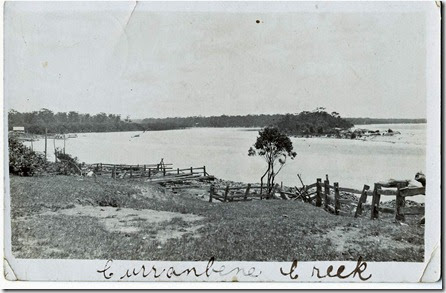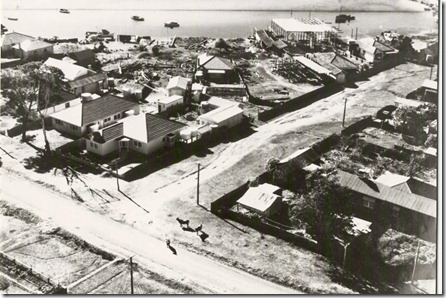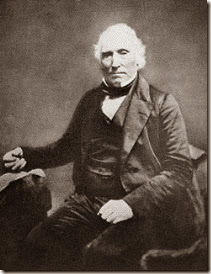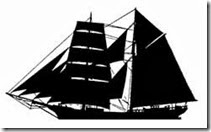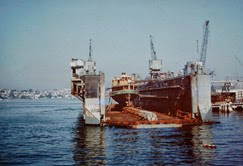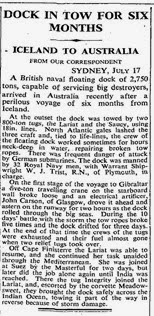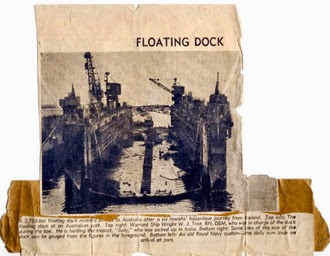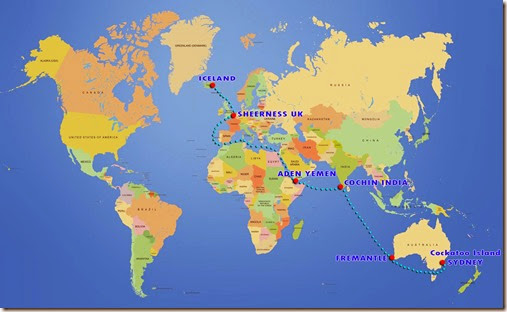 Regarded by many as one of the finest passenger ships every launched.
Regarded by many as one of the finest passenger ships every launched.
The Sobraon under full sail must have been an impressive site as it crossed the great ocean between England and Australia carrying passengers in comfort surrounded by luxury.
Exhibition.
If you visit the museum you will be impressed by a large brass bell engraved Sobraon 1866.
Accompanying the bell there is a display of paintings by Ian Hansen depicting the Sabraon in varying maritime scenes.
This ship was so impressive a small search across the net will reveal other paintings of the ship done by other marine artists.
 | 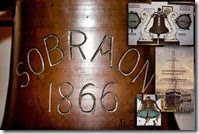 |  | The bell and part of one of the magnificent paintings by Ian Hansen. An an Australian stamp celebrating this mighty ship. |
Ships statistics.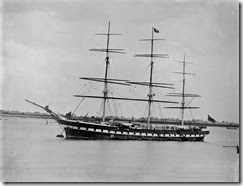 Built by Messrs. Hall, of Aberdeen, to the order of Lowther, Maxton & Co. Launched in November 1866, the Sobraon was the largest composite ship ever built, being constructed of solid teak with iron beams and frames
Built by Messrs. Hall, of Aberdeen, to the order of Lowther, Maxton & Co. Launched in November 1866, the Sobraon was the largest composite ship ever built, being constructed of solid teak with iron beams and frames
The vessel displaced some 2131 tons when empty and 3500 tons when loaded, with a length overall was 317 feet, and a beam of 40 feet. The lower masts were made of wrought iron, and the topmasts and lower yards on each
mast were of steel. With all sail set, the Sobraon had a spread of just over two acres of canvas.
SOBRAON could carry 90 first class passenger, 40 second class, and livestock below her decks.
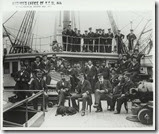

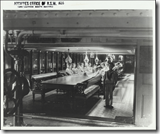
She traversed the ocean between England and Australia for 24 years and under full sail was capable of covering 2000 nautical miles in a week. She once covered the distance between Plymouth and Melbourne in 70 days. Not all journeys were pleasurable for the crew and passengers,
Not all journeys were pleasurable for the crew and passengers,
she often ran into storms and high seas on her voyages.
One though stood above all others in severity and a lesser ship may not have made it through.
The most serious incident.
The most serious storm experienced by the Sobraon was in 1889, when running her easting down. She was a little to the north of the Crozet Islands, and it began to breeze up on a Sunday morning. The glass gave every indication of a real snorter, and by 4 p.m. had tumbled down to 27.75. By that time the Sobraon had been shortened down to foresail, lower fore topsail, upper foretopsail reefed, main lower topsail and fore topmast staysail. The shift from N.W. to S.W. came at 5 o’clock, and the yards were hardly round before the foresail went, and in a few moments there was nothing left for it.
The sea was running in mountainous ridges, and with the foresail gone threatened every moment to poop her badly. It was too late to heave to and the ship was kept away before it. After four hours’ battling and over 30 men aloft a brand new foresail was bent and set reefed.
This was hardly done before the fore upper topsail blew away. However, with the foresail reefed and two lower topsails the Sobraon fled before the blast like a startled deer. The squalls every few minutes were terrific and in spite of such short canvas the Sobraon was making over 14 knots an hour.
The sea was all the time running higher and higher and breaking aboard in the most alarming fashion. During the night the greater portion of the bulwarks on the port side was carried away; a boat in davits, hanging 22 feet above the water, was filled by a sea and disappeared, the davits breaking off short, the main skylight over the saloon was washed away and tons of water found its way below before the open space could be covered over. The amount of water in
the saloon at this time can be imagined when passengers were actually being washed off their feet.
On deck there were many narrow escapes of men being washed overboard, the broken bulwarks being a great source of danger. The mate and three of the men were washed from the main life rail to the break of the poop, and, after being dashed up against the heavy boarding which had been put up to protect the fore end of the poop, managed to save themselves by the life-lines which had been stretch across. The forward deck house which held the galley and engine room was almost demolished and everything moveable in it was washed over the side.
The storm continued at its height from the Sunday afternoon until Wednesday morning. The passengers, who had been battened down for three days, were in a sorry plight owing to the quantities of water that had got below and the catering for them under such conditions proved very difficult.
As is usually the case after such a storm, the wind subsided very much quicker than the sea, and for a few hours on the Wednesday night, the wind having dropped completely and the ship losing way, the rolling was terrific. Fortunately everything held aloft in spite of the great strain on the masts during these few hours.
Other incidents
Twice she caught fire, firstly in 1884 when straw in a hold was accidentally lit by the carpenter, and again in 1888 when coal stored in the fore peak ignited by spontaneous combustion. On both occasions tragedy was averted by prompt action by her crew.
A few unlucky crew fell to their deaths from her rigging, while others survived the fall and resumed work.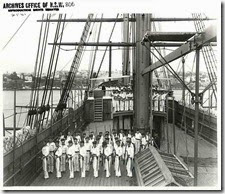 Renamed and put to a new use as HMAS Tingira.
Renamed and put to a new use as HMAS Tingira.
In 1891 the Sobraon was purchased by the NSW Government as a replacement for the boys’ training ship Vernon.
Sobraon was assigned to the State Welfare Department and refitted for use as a reformatory ship, where delinquent boys were trained in the skills for a maritime career.
Later commissioned into the RAN as HMAS Tingira (an aboriginal word for "open sea") in 1912, and refitted at the Cockatoo Docks, Sobraon continued in service until 1927 when she was sold.
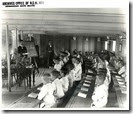
An ungraceful end.
After serving the people of Australia and the Navy so well for so many years you would have thought this mighty ship would have deserved a more glorious end to her story, attempts to preserve her as an exhibit were made, but as these last few pictures show, her fate ultimately saw her moored at Berry’s Bay until 1941, and with the onset of war, she was scrapped and broken up.
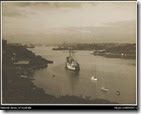 | 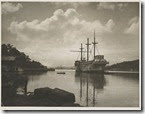 |  |
REF:
http://nla.gov.au/nla.pic-vn4654096
http://www.records.nsw.gov.au/state-archives/today-in-history/today-in-history-may
http://recordsearch.naa.gov.au/scripts/PhotoSearchItemDetail.asp?M=0&B=11642170&SE=1
http://trove.nla.gov.au/version/175966542
http://www.schoonerman.com/CLIPPER-SHIPS/sobraon_clipper_ship.htm


